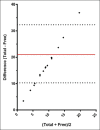Total Phenytoin concentration is not well correlated with active free drug in critically-ill head trauma patients
- PMID: 24991615
- PMCID: PMC4076917
- DOI: 10.4103/2279-042X.122376
Total Phenytoin concentration is not well correlated with active free drug in critically-ill head trauma patients
Abstract
Objective: Phenytoin is an antiepileptic drug used widely for prophylaxis and treatment of seizure after neurotrauma. Phenytoin has a complex pharmacokinetics and monitoring of its serum concentrations is recommended during treatment. Total phenytoin concentration is routinely measured for monitoring of therapy. In this study, we evaluated the correlation between phenytoin total and free concentrations in neurotrauma critically-ill patients to determine whether the phenytoin total concentration is a reliable predictor of free drug, which is responsible for the therapeutic effects.
Methods: A total of 40 adult head trauma patients evaluated for free (unbound) and total serum phenytoin concentrations. Patients were divided into two groups. Group A consists of 20 unconscious patients with severe head injury under mechanical ventilation and Group B consists of 20 conscious self-ventilated patients. Correlation and agreement between total and free phenytoin plasma concentrations were analyzed.
Findings: Pearson correlation analysis and Bland-Altman test showed weak to moderate correlation (r = 0.528) and poor agreement between free and total phenytoin concentrations in patients with severe trauma and higher Acute Physiology And Chronic Health Evaluation II (APACHE II) scores (Group A) and good correlation (r = 0.817) and moderate agreement in patients with mild to moderate trauma and lower APACHE II scores (Group B).
Conclusion: Our results indicated that total phenytoin serum concentration is not a reliable therapeutic goal for drug monitoring in severely-ill head trauma patients even in the absence of hypoalbuminemia, renal and hepatic failure. It seems justifiable to measure free phenytoin concentration in all severely ill neurotrauma patients.
Keywords: Critically-ill patients; Phenytoin; free drug concentration; head trauma; hypoalbuminemia.
Conflict of interest statement
Figures


References
-
- Annegers JF, Hauser WA, Coan SP, Rocca WA. A population-based study of seizures after traumatic brain injuries. N Engl J Med. 1998;338:20–4. - PubMed
-
- von Winckelmann SL, Spriet I, Willems L. Therapeutic drug monitoring of phenytoin in critically ill patients. Pharmacotherapy. 2008;28:1391–400. - PubMed
-
- Richens A. Clinical pharmacokinetics of phenytoin. Clin Pharmacokinet. 1979;4:153–69. - PubMed
-
- Zielmann S, Mielck F, Kahl R, Kazmaier S, Sydow M, Kolk J, et al. A rational basis for the measurement of free phenytoin concentration in critically ill trauma patients. Ther Drug Monit. 1994;16:139–44. - PubMed
LinkOut - more resources
Full Text Sources
Other Literature Sources

